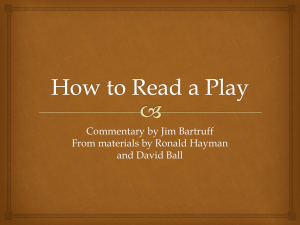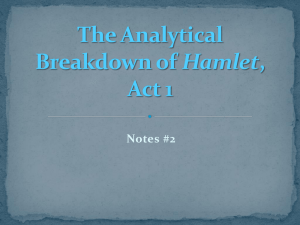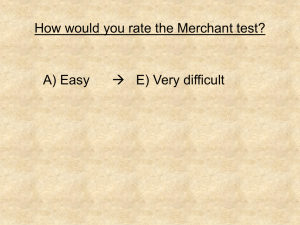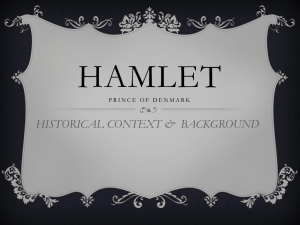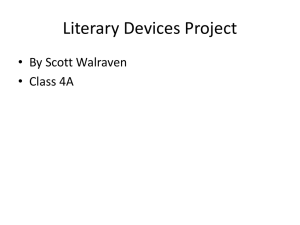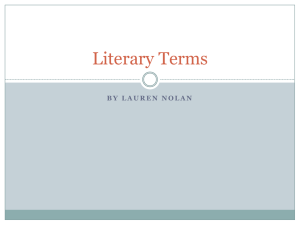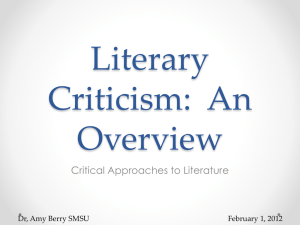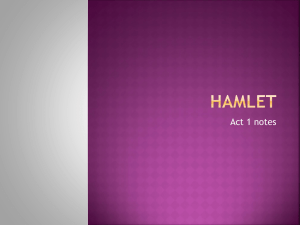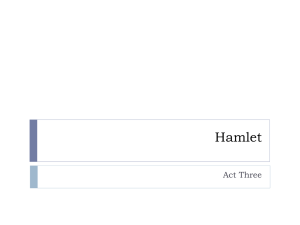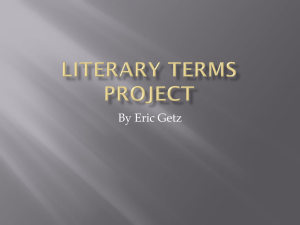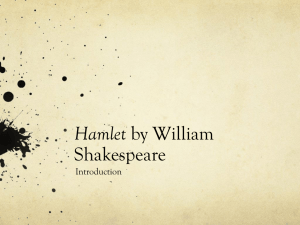Literary Terms
advertisement
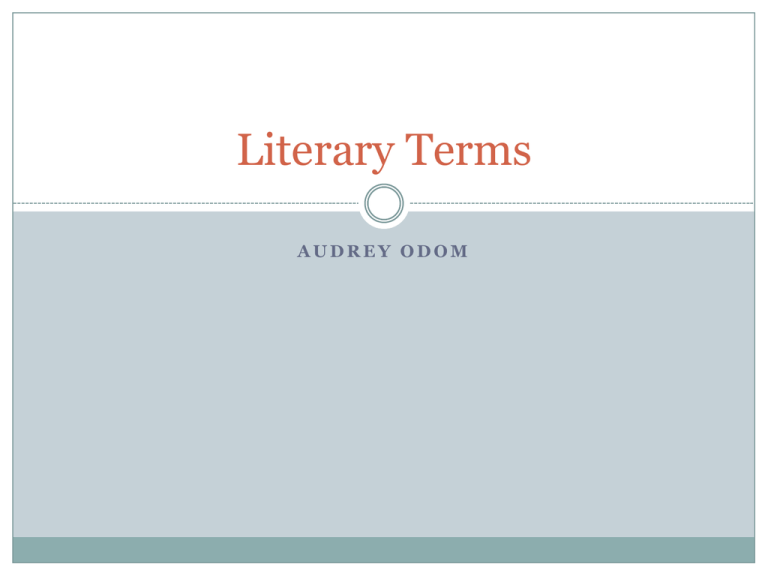
Literary Terms AUDREY ODOM Imagery Visually descriptive or figurative language “paints a picture” of the scene in your head. Hamlet: O, that this too too solid flesh would melt, Thaw and resolve itself into a dew! (Act I, Scene ii, Lines 129-130) Imagery in Music “Picture yourself in a boat on a river with tangerine trees and marmalade skies” -The Beatles “Lucy in the Sky with Diamonds” Simile The comparison of two very different things using “like” or “as” Hamlet: Pale as his shirt (Act II, Scene i, Line 81) Simile in music “Telephone wires above are sizzling like a snare” -Lana Del Rey “Summertime Sadness” Metaphor A word or phrase used to refer two things to show that they are similar Hamlet: To die, to sleep– To sleep, perchance to dream (Act III, Scene i, Lines 64-65) Metaphor in Movie Title “Gone with the Wind” Personification Giving human characteristics/actions to something nonhuman. Hamlet: But, look, the morn, in russet mantle clad, Walks o’er the dew of yon high eastward hill. (Act I, Scene i, Lines 166-167) Personification in Movies “Ted” Apostrophe The addressing of a usually absent person or a usually personified thing rhetorically Hamlet: Let me not think on’t: frailty, thy name is women (Act I, Scene ii, Line 146) Apostrophe in Poetry O Captain! My Captain! -Walt Whitman Symbol A thing/theme that represents something else with a deeper meaning Hamlet: Poison Poison is a symbol of disloyalty and corruption and death Upon my secure hour thy uncle stole With juice of cursed hebenon in a vial And in the porches of my ears did pour The leperous distilment (Act I, Scene v, Lines 61-64) Symbols in Movies: Luke Skywalker wear black throughout the return of the Jedi symbolizing the possibility of him turning to the dark side. Allegory A story or picture that can be interpreted to reveal a hidden meaning, an allusion to another meaning Hamlet: O heart, lose not thy nature. Let not ever The soul of Nero enter this firm bosom. (Act III, Scene ii, Lines 376-377) Hamlet is referring to Nero, who killed his mother, prior to when Hamlet is going to visit Gertrude. He hopes not to kill her. Allegory in Books: Animal Farm by George Orwell The Chronicles of Narnia by C.S. Lewis Paradox A statement that says two opposite things contradict each other, but both are true Hamlet: I must be cruel, only to be kind (Act III, Scene iv, Line 178) Hyperbole Exaggerated statements not to be taken literally Hamlet: With such deterity to incestuous sheets! (Act I, Scene ii, Line 159) Hyperboles in Music “You Ain’t Nothin But a Hound Dog” -Elvis Presley Understatement The presentation of something being smaller or less important than it actually is. Hamlet: It is not nor it cannot come to good. But break, my heart; for I must hold my tongue. (Act I, Scene ii, Lines 158-159) Understatement in Music “It’s the End of the World as We Know It” -R.E.M. Irony The use of words that mean the opposite of what you really think. Can be used for humor and drama. Hamlet: (Dramatic Irony) Get thee to a nunnery. (Act III, Scene 1, Line 121) Irony in Movies “50 First Dates” Adam Sandler doesn’t want a long lasting relationship until he meets a girl with short term memory Chiasmus An inverted relationship between the syntactic elements of parallel phrases Hamlet: King: Thanks, Rosencrantz and gentle Guildenstern. Queen: Thanks, Guildenstern and gentle Rosencrantz. (Act II, Scene ii, Lines 33-34) Metonymy Substitution of the name of an attribute for that of the thing meant Hamlet …To die, to sleep No more, and by a sleep to say we end (Act III, Scene I, Lines 60-61) Metonymy in Books “Her voice is filled with money” -F. Scott Fitzgerald “The Great Gatsby” Synecdoche A figure of speech in which a part is made to represent the whole Hamlet: O, that this too too solid flesh would melt, Thaw and resolve itself into a dew! (Act I, Scene ii, Lines 129-130) Synecdoche in daily phrase: “All hands on deck!” Repartee Conversation characterized by quick, witty comments Hamlet: Hamlet: Well, God-a-mercy Polonius: Do you know me, my lord? Hamlet: Excellent well. You are a fishmonger. Polonius: Not I, my lord. Hamlet: Then I would you were so honest a man. Polonius: Honest, my lord! (Act II, Scene ii, Lines 171-176) Stichomythia Dialogue in which two characters speak alternate lines of verse Hamlet: Laertes: Where is my father? Claudius: Dead Gertrude: But not by him (Act IV, Scene 5, Line 28) Stock Characters Character who is normally one-dimensional but sometimes stock personalities are deeply conflicted, rounded characters. Hamlet: Polonius Polonius is a stock character because he has former wisdom but still provides comic relief. Stock Characters in TV: Normally a guest star that appears for one episode is considered a stock character Alliteration The occurrence of the same letter or sound at the beginning of adjacent or closely connected words Hamlet: With witchcraft of his wit, with traitorous gifts (Act I, Scene v, Line 43) Alliteration in Real Life: Dunkin Donuts Assonance Repetition of the sound of a vowel in non-rhyming stressed syllables near enough to each other for the echo to be noticeable Hamlet: Doubt thou the stars are fire; Doubt that the sun doth move; (Act II, Scene ii, Lines 115-116) Assonance in Music “I’m a mess in a dress” -Orianthi “According to You” Consonance Recurrence or repetition of consonants especially at the end of stressed syllables Hamlet: No more, and by a sleep to say we end (Act III, Scene I, Line 61) Consonance in Music “Whisper word of wisdom, let it be” -The Beatles “Let it Be” Rhyme Correspondence of sound between words Hamlet: …The plays the thing Wherein I’ll catch the conscience of the king. (Act II, Scene ii, Lines 591-592) Rhyme in Music “Hope that you fall in love and it hurts so bad, the only way you can know is give it all that you have” -One Republic “I Lived” Rhythm A strong, regular, repeated pattern of movement or sound Hamlet: The rhythm in Hamlet corresponds to iambic pentameter Rhythm in Music All music has some sort of rhythm in it, the drums or the bass guitar usually provides the rhythm Meter Arranged and measured rhythm in verse Hamlet: When we have shuffled off this mortal coil, Must give us pause: there’s the respect End-Stopped Line A line that ends with a definite punctuation mark (period/colon). Hamlet: Admit no messengers, receive no tokens. (Act II, Scene ii, Line 143) Run-On Line When the natural pause in reading does not coincide with the end of a line, the speaker continues without pause Hamlet O God, your only jig-maker. What should a man do but be merry? For look you how cheerfully my mother looks, and my father died within’s two hours. (Act III, Scene ii, Lines 118-120) Caesura A break between words within a metrical foot. Hamlet: To be, or not to be, that is the question (Act III, Scene i, Line 56) Free Verse Poetry that does not rhyme or have a regular meter Hamlet: The common people in this era would speak in free verse as opposed to the higher class, who would speak in prose Example of Free Verse in Poetry “Winter Poem” by Nikki Giovanni Iambic Pentameter A line that has ten syllables in each line, but the alternate syllable is stressed Hamlet: To be, or not to be: that is the question. (Act III, Scene I, Line 56) Iambic Pentameter in Other Literature: Arise, fair sun, and kill the envious moon, Who is already sick and pale with grief, -Shakespeare, Romeo and Juliet Grammatical/Rhetorical Pauses Grammatical- A pause introduced by a mark of punctuation Rhetorical- A natural pause not marked by punctuation Hamlet: But in a fiction, in a dream of passion, (Act II, Scene ii, Line 535) Grammatical Pause in Music: “It takes two, two sides to every story” -Katy Perry “It Takes Two” Concluding Couplet Two successive lines that are rhymed and have the same meter Hamlet: Till then sit still, my soul. Foul deeds will rise, Though all the earth o’erwhelm them, to men’s eyes. (Act I, Scene 2, Lines 257-258) Concluding Couplet in Poetry “If this be error and upon me proved, I never writ, nor no man ever loved.” -Shakespeare Sonnet 116
